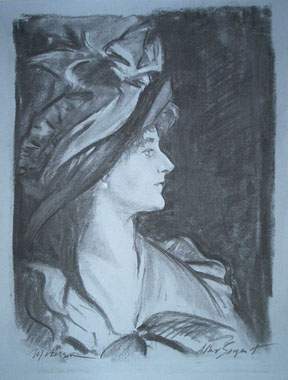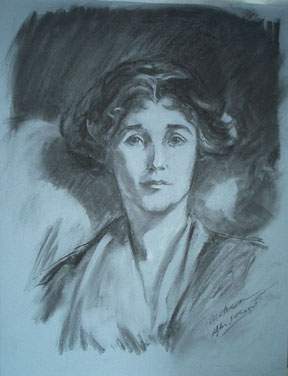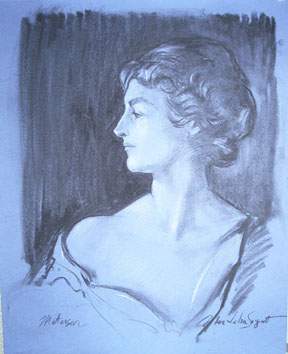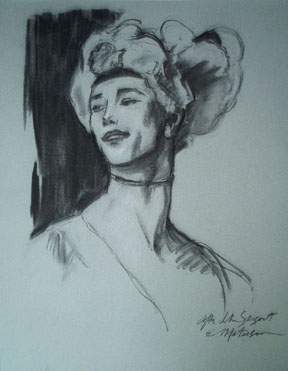 Gertrude Kingston
(After John
Singer Sargent)
Edward
Materson - American Artist Sculptor, Painter
Charcoal
on toned paper (Canson Meintes)
Jpg:
Edward Materson
Gertrude Kingston
(After John
Singer Sargent)
Edward
Materson - American Artist Sculptor, Painter
Charcoal
on toned paper (Canson Meintes)
Jpg:
Edward Materson
 Edward:
Some years ago, with permission, I
copied the little
Edward:
Some years ago, with permission, I
copied the little  girl
seated in the foreground in "The Boit Children" at the Boston Museum of
Fine Arts. It was a wonderful experience getting that close to the work
of a man I so much admire. girl
seated in the foreground in "The Boit Children" at the Boston Museum of
Fine Arts. It was a wonderful experience getting that close to the work
of a man I so much admire.
In
the same vein, these drawings or sketches, were done with a view toward
self-improvement; much as Sargent, himself, made copies of Velazquez and
Franz Hals.
Natasha:
This is wonderful! When did you first
learn about Sargent?
Edward:
Probably as a young man visiting the Metropolitan Museum of Art. I grew
up in New York City (the larger city of five boroughs) and made visits
into Manhattan at a very young age on school trips, etc..


Marchioness
of Bath
(After John
Singer Sargent)
Edward
Materson - American Artist Sculptor, Painter
Charcoal
on toned paper (Canson Meintes)
Natasha:
You say you did these towards improving
yourself. What is he able to do that just blows you away?
Edward:
If you look very carefully at his use of value which is so evident in the
black and white charcoal drawings you find that he is playing with all
the notes. There are rich black passages luxurious and powerful which juxtapose
very subtle halftones, particularly around the eyes and mouth.

 Mrs. Richard
D. Sears
(After John
Singer Sargent)
Edward
Materson - American Artist Sculptor, Painter
Charcoal
on toned paper (Canson Meintes)
Mrs. Richard
D. Sears
(After John
Singer Sargent)
Edward
Materson - American Artist Sculptor, Painter
Charcoal
on toned paper (Canson Meintes)
Natasha:
Is there a medium of his that you love
more than others? And are there things in Sargent's art that you love but
don't necessarily want to emulate in your own?
Edward:
His oils, to me, display a virtuosity that is almost musical. The rich,
daring brushstrokes evidence the ability to "think on one's feet". There
is none of that laborious "peck, peck, peck" that seems to be common in
so much realism today. I can't think of anything I would not want to emulate
other than the tendency of some of society portraits to stylishly
elongate figures and necks. Aside from that his work is, as Henry James
remarked of Sargent himself, "civilized to its fingertips". The strange
thing is that such an artist could also display such passion.
Natasha:
Is there a painting that demonstrates
what you are talking about?
 Edward:
There are so many examples both in oil and watercolor where he makes one
bold stroke count for hundreds by a lesser artist. Lady Agnew has always
held a fascination for me and looking again at a copy of her portrait I
am impressed by the gold locket chain. Think of drawing that line, with
all its subtle variations of color and tone over the already carefully
modelled flesh and clothing tones. Also the single stroke highlights on
the right ear (left to the viewer), the nose, the eyes. They are not only
correct in value and color but, of course, also in placement. Edward:
There are so many examples both in oil and watercolor where he makes one
bold stroke count for hundreds by a lesser artist. Lady Agnew has always
held a fascination for me and looking again at a copy of her portrait I
am impressed by the gold locket chain. Think of drawing that line, with
all its subtle variations of color and tone over the already carefully
modelled flesh and clothing tones. Also the single stroke highlights on
the right ear (left to the viewer), the nose, the eyes. They are not only
correct in value and color but, of course, also in placement.
Natasha:
For any artist, especially a mature artist, there is always that balance
between learning form old masters and finding your own artistic voice.
Sargent studied many old Masters and would do so throughout his entire
life -- well beyond his student years. At the peak of his game he was still
going off to Spain, or somewhere to copy El Greco or whomever. For you,
how does this play out. Is it the joy of going into uncharted waters? Are
you searching for borrowing a new techniques which you can add to your
quiver of arrows? Is it just a continual evolving process? Is it emotional
that you're connecting with the lineage of artists past?
Edward:
All of the above. I believe one must adopt a certain assurance as a professional
artist which is actually at odds with the humility one needs to progress
in his or her art. Leonardo Da Vinci said something to the effect that
"he only will advance in his art whose critical facilities exceed his talent."


Nijinsky
(After John
Singer Sargent)
Edward
Materson - American Artist Sculptor, Painter
Natasha:
I know you're a big fan of Robert Henri, so am I, and want to show him
as a "featured artist". I also assume, especially from where you are from
(Maine) that you must draw a lot of inspirations from Winslow Homer as
well, If you could pick one moment in time to go back to, and sort of sit
on the wall like a fly and observe, where would you want to go and whom
would you want to see
Edward:
That's a tough one. While I admire the
work of Winslow Homer very much I think I would like to have been a contemporary
of Sargent and had the pleasure of watching him work. The idea of being
part of his world is appealing because no matter how much technical prowess
any of us develop today (and there seem to be more artists working beautifully
in a realistic vein all the time), none of us can actually recreate that
world of elegance that all the people in Sargent's world evoke. Women no
longer spend hours elegantly and demurely reading in beautiful gardens.
Men wear Levi's and sweat shirts, not jackets and ties. All of that is
pretty foreign to today's world, at least it seems to me.
Natasha:
Thank you so much Edward, for sharing these with us and sharing some
of your thoughts. I known from reading your site that you prefer
your art to speak for itself. I personally like that philosophy. So I know
that it's sort of against the grain for you to sit down with me and talk
about it.
Edward:
There's a distinction between my explaining
what Sargent's work means to me and the idea of giving a lengthy explanation
of what my own work means. I dislike spending more time reading a title
than looking at a work.
Natasha:
You don't mind me inviting everyone over to your site, do you?
Edward:
Of course I don't mind.
Natasha:
Imagine that.
<wink>
The
Art of Edward Materson |